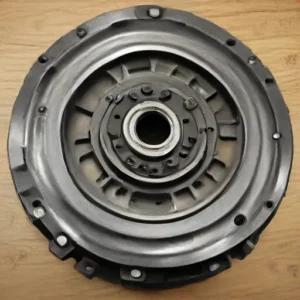The most common Kawasaki Mule SX problems are starter issues, fuel problems, hard to shift, transmission issues, brake problems, clutch problems, steering issues, dashboard problems and engine overheating.
Here we explore these problems in detail and provide easy solutions.
Kawasaki Mule SX Problems and Solutions
Now we are going to explore the most common problems of Kawasaki Mule SX with their easy solutions. Also explore the problems of Kawasaki Mule Pro Max.
1. Starter Problems

If you’re facing starter issues with your Kawasaki Mule UTV, you’ll likely notice some common symptoms. These can include:
- The engine doesn’t start when I turn the key
- A clicking sound happens when I try to start the engine
- Intermittent starting problems
- Complete failure to start
Recognizing these symptoms early can help in diagnosing the problem more accurately and swiftly.
Potential Causes and Solutions
Several factors can contribute to starter issues in your Kawasaki Mule SX. Let’s explore some of the most frequent causes:
Battery Issues
Often, a weak or dead battery is the culprit. Ensure your battery is fully charged and connections are clean and tight. A multimeter can help you check the battery’s voltage; it should read around 12.6 volts when fully charged.
Starter Motor Problems
The starter motor itself may be faulty. If the motor is not engaging properly, it might require replacement. Inspecting and cleaning the starter motor can sometimes resolve minor issues.
Wiring and Connections
Corroded or loose wiring can impede the flow of electricity, causing starter problems. Inspect the wiring harness and connections for any signs of wear or corrosion. Tighten and clean as necessary.
2. Kawasaki Mule SX Fuel Problems

One of the most prevalent issues with the Kawasaki Mule SX is difficulty starting, which is often linked to fuel problems. This can be caused by a clogged fuel filter, dirty carburetor, or stale fuel.
Another common issue is poor engine performance, where the vehicle may sputter or lose power. This can be due to a faulty fuel pump or contaminated fuel. Also explore the Kawasaki KRX 1000 problems.
Causes of Fuel Problems
Understanding the root causes of these fuel problems is crucial. A clogged fuel filter can restrict the flow of fuel to the engine, leading to starting issues and poor performance.
Dirty carburetors can also impede fuel delivery. Stale fuel, which loses its combustibility over time, can cause the engine to run inefficiently.
Additionally, water contamination in the fuel can lead to serious engine problems.
Solutions
To troubleshoot and fix these issues, start by checking the fuel filter and replacing it if necessary. Cleaning the carburetor can also resolve many problems.
Make sure to use fresh, high-quality fuel and consider adding a fuel stabilizer if the vehicle will be stored for an extended period.
Regular maintenance, such as inspecting the fuel lines and replacing the fuel pump if needed, can prevent many fuel-related issues.
3. Shifting Problems

One of the most frequent causes of hard shifting in the Kawasaki Mule SX is related to the clutch system. If the clutch is not properly adjusted or has worn out components, it can lead to difficulties in shifting gears smoothly.
Another common cause could be issues with the transmission fluid. Low or contaminated transmission fluid can hamper the efficiency of gear shifting.
Solutions
To address the clutch-related issues, it is recommended to regularly check and adjust the clutch cable. Ensuring that the cable tension is correct can significantly improve shifting performance.
Additionally, inspect the clutch plates for wear and replace them if necessary. For transmission fluid concerns, make it a routine to check the fluid levels and quality.
If the fluid appears dirty or is at a low level, drain and refill with the appropriate type of transmission fluid as specified in the Kawasaki Mule SX manual.
When to Seek Professional Help
While regular maintenance can resolve most shifting issues, there are instances where professional intervention is required.
If you have tried the aforementioned solutions and still experience difficulties, it might be time to consult a qualified mechanic.
Persistent problems could indicate deeper mechanical issues that require specialized tools and expertise to diagnose and fix.
4. Transmission Problems

One of the most frequently reported issues with the Kawasaki Mule SX is difficulty in shifting gears. Users often find the transmission either too stiff or entirely stuck.
This issue can be particularly frustrating if you’re relying on the vehicle for work. The problem may stem from several factors, including a misaligned gear shift lever, worn-out transmission fluid, or issues with the clutch.
Diagnosing the Issues
To diagnose transmission problems, the first step is to check the transmission fluid. Low or dirty fluid can cause gears to grind and make shifting difficult.
Ensure that the fluid is at the correct level and is clean. If the fluid needs to be changed, follow the manufacturer’s recommendations for the type and amount of fluid.
Another common issue is a misaligned gear shift lever. If the lever is not properly aligned, it can cause difficulty in shifting.
Inspect the lever for any signs of wear or misalignment and adjust it if necessary. Additionally, the clutch can sometimes be the culprit. Check for clutch wear and adjust or replace it as needed.
5. Brake Issues

One of the most frequent brake problems in Kawasaki Mule SX is brake squealing. This can be caused by dust or debris caught in the brake pads, worn-out pads, or glazed rotors.
If the brakes are squealing, it’s essential to clean the brake components and, if necessary, replace the pads.
Another issue is spongy brakes, which may occur due to air in the brake lines or low brake fluid levels.
To address this, you need to bleed the brakes and ensure the brake fluid reservoir is filled to the recommended level.
Additionally, regularly checking for leaks in the brake lines can prevent this problem.
Also explore the best offroad vehicles
Solutions
To keep your Kawasaki Mule SX brake system in optimal condition, it’s important to perform routine maintenance.
Regularly inspect the brake pads for wear and replace them if they are less than 1/8 inch thick. Ensure the rotors are smooth and free from grooves or warping, and replace them if necessary.
Additionally, always use high-quality brake fluid as specified in the owner’s manual. Contaminated or incorrect brake fluid can lead to reduced braking efficiency and potential damage to the brake system.
6. Kawasaki Mule SX Clutch Problems

One common problem is clutch slipping. This occurs when the clutch doesn’t fully engage, causing a loss of power and efficiency.
Another issue is clutch dragging, where the clutch fails to disengage completely, leading to difficult gear shifting.
Additionally, noise and vibrations during operation can indicate clutch wear or damage.
Causes and Symptoms
Clutch slipping can be caused by worn-out clutch plates or a weak clutch spring. Symptoms include a noticeable decrease in power and acceleration, as well as higher engine RPMs without a corresponding increase in speed.
Clutch dragging might result from a misadjusted clutch cable or hydraulic issues. If you experience difficulty in shifting gears or unusual noises, it’s essential to inspect the clutch components for wear and tear.
Solutions
Regular maintenance is key to preventing clutch problems in your Kawasaki Mule SX. Make sure the clutch cable is correctly adjusted and lubricated.
If you notice any signs of clutch wear, such as slipping or dragging, consider replacing the clutch plates and springs. It’s also vital to check for any hydraulic issues and address them promptly.
By staying vigilant and performing routine checks, you can extend the life of your vehicle’s clutch system and prevent costly repairs.
7. Steering Problems

Many users have reported experiencing stiffness or difficulty when steering their Kawasaki Mule SX on offroading. This issue can be particularly problematic when navigating tight turns or rough terrains.
Another frequently mentioned problem is the presence of unusual noises when turning the steering wheel. Such issues can significantly impact the overall driving experience and safety.
Causes of Steering Problems
Understanding the main causes of these steering problems is crucial for effective troubleshooting. The most prevalent causes include:
- Low Power Steering Fluid: Insufficient fluid levels can cause the steering to become stiff and unresponsive.
- Worn-Out Steering Components: Over time, components like the steering rack, tie rods, and ball joints can wear out, leading to steering issues.
- Misalignment: If the wheels are not properly aligned, it can cause steering difficulties and uneven tire wear.
Solutions
Fortunately, many of these steering problems can be remedied with regular maintenance and timely interventions. Here are some solutions:
- Check and Refill Power Steering Fluid: Regularly inspect the power steering fluid level and refill it as needed to ensure smooth steering.
- Inspect and Replace Worn Components: Periodically check the steering components for wear and tear. Replace any damaged parts promptly to prevent further issues.
- Wheel Alignment: Ensure that the wheels are properly aligned by seeking professional alignment services when necessary.
8. Kawasaki Mule Dashboard Problems

One of the most common issues with the Kawasaki Mule SX dashboard is the display not functioning correctly. This can manifest as the screen going blank or displaying incorrect information.
Another frequent problem is the dashboard warning lights either not illuminating when they should or staying on without any apparent reason.
According to user reports, the most affected lights are the check engine and oil pressure indicators.
Causes and Solutions
Several factors can contribute to these dashboard issues. Electrical problems, such as loose connections or faulty wiring, are often culprits. In some cases, the problem may stem from a defective dashboard unit itself. Here are steps to troubleshoot and fix these issues:
- Check Connections: Ensure all electrical connections to the dashboard are secure. Loose wires can cause intermittent issues.
- Inspect Fuses: A blown fuse can lead to dashboard malfunctions. Replace any damaged fuses with the appropriate type and rating.
- Test the Battery: A weak or failing battery can cause erratic dashboard behaviour. Make sure the battery is fully charged and in good condition.
- Consult a Professional: If the issue persists, it may be best to consult a Kawasaki service technician for a thorough diagnostic and repair.
9. Engine Overheating

Engine overheating in the Kawasaki Mule SX can often be traced back to several common causes:
- Low Coolant Levels: One of the most frequent reasons for engine overheating is low coolant levels. Coolant is essential for maintaining the engine’s temperature, and a lack of it can lead to increased heat.
- Faulty Thermostat: The thermostat controls coolant flow. If it becomes stuck or malfunctions, the engine may overheat due to insufficient coolant circulation.
- Radiator Issues: Blocked or damaged radiators can hinder the cooling process, resulting in overheating. Dirt, debris, and physical damage can all impact the radiator’s efficiency.
Solutions
Addressing overheating problems in your Kawasaki Mule SX can be straightforward if you follow these preventive measures:
- Regular Coolant Checks: Ensure that the coolant levels are always within the recommended range. Regularly inspect for leaks and refill coolant as necessary.
- Thermostat Maintenance: Periodically inspect the thermostat for signs of wear or malfunction. Replacing a faulty thermostat promptly can prevent overheating issues.
- Radiator Cleaning: Keep the radiator clean and free of debris. Use a soft brush or compressed air to remove dirt and ensure that air can flow freely through the radiator fins.
Kawasaki Mule SX Specifications, features & performance
| Category | Details |
| Manufacturer | Kawasaki Motors Corporation |
| Model | Mule SX |
| Type | Utility Task Vehicle (UTV) |
| Engine | 4-stroke, single-cylinder, OHV, 401cc |
| Power Output | Approximately 13 horsepower |
| Transmission | Continuously Variable Transmission (CVT) with high/low range and reverse |
| Drivetrain | 2WD |
| Dimensions | Length: 106.7 inches, Width: 52.6 inches, Height: 70.1 inches |
| Wheelbase | 70.1 inches |
| Ground Clearance | 6.1 inches |
| Curb Weight | Approximately 993 pounds |
| Payload Capacity | 400 pounds |
| Towing Capacity | 1,100 pounds |
| Fuel Capacity | 4.2 gallons |
| Suspension (Front) | MacPherson strut |
| Suspension (Rear) | Unit swing with dual adjustable shocks |
| Brakes (Front/Rear) | Hydraulic drum |
| Tires | Front: 22×9-10, Rear: 22×11-10 |
| Seating Capacity | 2 |
| Color Options | Timberline Green, Dark Royal Red |
| Safety Features | Seat belts, ROPS (Roll Over Protective Structure), headlights, taillights |
| Additional Features | Digital fuel gauge and hour meter, tilting cargo bed with latches, adjustable seat position, 12V DC outlet |
| Price Range | $7,000 – $8,000 (varies by dealer and location) |
| Warranty | 3-year limited warranty |
| User Reviews | Generally positive; users appreciate its durability, compact size, and reliability. Some criticisms include limited power for heavy-duty tasks and basic interior features. |
Conclusion
While the Kawasaki Mule SX is a robust vehicle, being aware of common problems and their solutions can enhance its longevity and performance. Regular maintenance and timely repairs help prevent these problems.
I hope this guide has provided useful insights into the common problems faced by Kawasaki Mule SX owners. By staying informed and proactive, you can ensure that your Mule SX remains in top condition for years to come.
FAQs about Kawasaki Mule SX
1. What is the engine size of the Kawasaki Mule SX?
The Kawasaki Mule SX has a 401cc, 4-stroke, single-cylinder engine.
2. What is the towing capacity of the Kawasaki Mule SX?
The Kawasaki Mule SX can tow up to 1,100 pounds.
3. How many people can the Kawasaki Mule SX seat?
The Kawasaki Mule SX seats two people.

